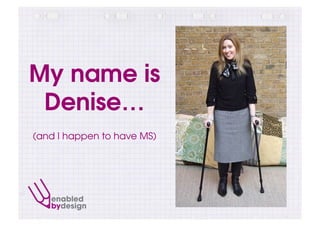Enabled by Design at SXSW 2013 (without audio)
- 1. 3D Printing for People with Disabilities SXSW, Austin, Texas 10 March 2013 #3Dability
- 3. My name is DeniseŌĆ” (and I happen to have MS)
- 4. view online at: http://vimeo.com/futuregov/ebdsxsw13
- 5. What is Assistive Technology? ŌĆ£Any product or service designed to enable independence for disabled & older peopleŌĆØ (Source: user group consultation at the KingŌĆÖs Fund in 2001) From: To:
- 6. Plastic not so ┤┌▓╣▓į│┘▓╣▓§│┘Š▒│”ŌĆ”
- 8. ╠² ŌĆ£Design philosophy targeting Design for All use of products, services & systems by as many people as possible without need for adaptationŌĆØ
- 9. Battle of the blandŌĆ” vs
- 11. From ŌĆśuniversalŌĆÖ to ŌĆśpersonalŌĆÖ design
- 12. customisation
- 13. crowdsourcing
- 14. new materials
- 15. 3D printing
- 16. Bene’¼üts of 3D printing for disability ŌĆóŌĆ» Potential for customisation / personalisation ŌĆóŌĆ» Modify / iterate designs on the go ŌĆóŌĆ» Becoming increasingly available ŌĆóŌĆ» Ability to scale according to needs ŌĆóŌĆ» Replace broken parts easily ŌĆóŌĆ» Reasonably low cost ŌĆóŌĆ» Relatively quick ŌĆóŌĆ» Range of materials available ŌĆóŌĆ» Open source designs
- 17. Trends in need Prosthe)cs, ╠²Tac)les ╠²and ╠²Equipment
- 18. Bespoke Innovations: Customisable Prosthetic Fairings
- 19. Tactile
- 20. Equipment
- 21. And other (internet of) thingsŌĆ”
- 22. Kickstarting a *true* personalisation movement
- 23. Paul had a kettle problem
- 24. But with a little help from a process (and some friends)
- 25. Not anymore!
- 26. JudgeŌĆÖs Choice: PaulŌĆÖs Kettle
- 27. Free Hand
- 28. Oh and that 3D printing thingŌĆ”
- 32. view online at: http://labs.ideo.com/2013/01/16/enabled-by-designathon/
- 33. Coming next to EbD: a tailormade service
- 34. Where to ’¼ünd us: Website: http://enabledbydesign.org/ Facebook: http://www.facebook.com/ enabledbydesign Twitter: http://twitter.com/enabledby Flickr: http://www.’¼éickr.com/enabledbydesign/ Email: denise@enabledbydesign.org


































